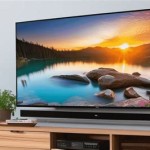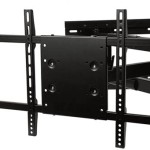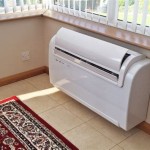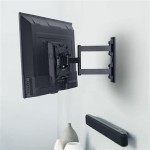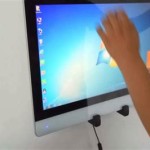Understanding TV Wall Mounts for 100 Lbs Televisions
Television wall mounts have become increasingly popular due to their space-saving design, aesthetic appeal, and ability to improve viewing angles. When selecting a wall mount, the weight capacity is a critical factor. This article focuses on TV wall mounts specifically designed to support televisions weighing up to 100 pounds. It will delve into the types of mounts available, installation considerations, safety protocols, and essential features to look for to ensure a secure and optimal viewing experience.
The primary function of a TV wall mount is to securely attach a television to a wall, freeing up floor space that would otherwise be occupied by a TV stand. This is particularly beneficial in smaller rooms or when aiming for a minimalist design. Furthermore, a wall mount allows for greater flexibility in positioning the TV, enabling viewers to optimize the viewing angle and reduce glare. The capacity to support a 100 lbs television signifies a robust construction capable of handling larger and heavier screens, often ranging from 55 to 75 inches, depending on the TV model.
Choosing the incorrect wall mount can lead to serious consequences, including damage to the television, the wall, and potential injury. Therefore, understanding the different types of mounts and their weight capacities is paramount. It's not enough for the mount to simply "hold" the TV; it must do so safely and reliably, ensuring that the television remains securely attached over time.
Types of TV Wall Mounts for 100 Lbs Televisions
Several types of TV wall mounts are designed to handle televisions weighing up to 100 pounds, each offering distinct features and benefits. The most common types include fixed, tilting, full-motion, and low-profile mounts. Understanding the characteristics of each type will assist in selecting the most appropriate mount for specific needs and viewing preferences.
Fixed Mounts: Fixed mounts, also known as flat mounts, are the simplest and most basic type of TV wall mount. They hold the television in a fixed position, typically very close to the wall. This type of mount is ideal for situations where the optimal viewing angle is already established, and adjustments are not required. The minimal distance between the TV and the wall, often less than an inch, creates a clean and streamlined look. Fixed mounts are usually the most affordable option and are relatively easy to install. However, they offer no flexibility in terms of adjusting the viewing angle or accessing the back of the television for cable management.
Tilting Mounts: Tilting mounts allow the television to be tilted vertically, typically downward, to improve the viewing angle from higher positions or to reduce glare from windows or lights. This type of mount offers a degree of flexibility that fixed mounts lack, making it suitable for bedrooms or rooms where the seating position is higher than the TV. The tilting mechanism is generally easy to operate, and the mount maintains a relatively low profile compared to full-motion mounts. Cable management can still be somewhat challenging, as the TV remains close to the wall, even when tilted.
Full-Motion Mounts: Full-motion mounts, also known as articulating mounts, provide the greatest flexibility in positioning the television. They allow the TV to be extended, swiveled, and tilted in various directions, enabling viewers to achieve the optimal viewing angle from virtually any location in the room. This type of mount is particularly useful for open-concept living spaces or rooms with multiple seating areas. Full-motion mounts typically consist of multiple arms and joints that allow for a wide range of movement. They also make accessing the back of the television for cable management much easier. However, full-motion mounts are generally the most expensive option and require more careful installation to ensure stability and prevent sagging. They also tend to protrude further from the wall than fixed or tilting mounts.
Low-Profile Mounts: Low-profile mounts are designed to keep the television as close to the wall as possible, similar to fixed mounts. However, they often include features that fixed mounts lack, such as a small degree of tilt or swivel. These mounts are ideal for situations where a clean, minimalist look is desired, but some adjustability is still needed. They are a good compromise between fixed and tilting mounts, offering a balance of aesthetics and functionality. Installation is generally straightforward, and the cost is typically moderate.
When selecting a TV wall mount, it is crucial to consider the viewing habits, room layout, and aesthetic preferences. For instance, if the television will primarily be viewed from a single location, a fixed or tilting mount may suffice. However, if the viewing angle needs to be adjusted frequently or if the television is located in a large room with multiple seating areas, a full-motion mount is likely the best choice.
Installation Considerations for 100 Lbs TV Wall Mounts
Proper installation is paramount to ensuring the safety and stability of a TV wall mount, particularly when supporting a television weighing up to 100 pounds. The installation process involves several key steps, including identifying wall studs, attaching the mount to the wall, and securing the television to the mount. Neglecting any of these steps can compromise the integrity of the installation and potentially lead to a hazardous situation.
Identifying Wall Studs: The most critical aspect of installing a TV wall mount is securely attaching it to wall studs. Wall studs are vertical wooden beams that provide structural support to the wall. Attaching the mount directly to drywall alone is insufficient to support the weight of a large television. A stud finder is a tool used to locate wall studs accurately. Electronic stud finders detect changes in density within the wall, while magnetic stud finders locate metal fasteners, such as nails or screws, that are attached to the studs. Once the studs are located, mark their positions clearly on the wall using a pencil. It is advisable to verify the location of the studs by drilling a small pilot hole to confirm that the drill bit enters solid wood.
Attaching the Mount to the Wall: Once the wall studs are identified, the next step is to attach the wall plate of the TV mount to the studs. The wall plate is the part of the mount that attaches directly to the wall. Align the wall plate with the marked stud locations and use lag bolts or other heavy-duty fasteners to secure it to the studs. Ensure that the bolts are long enough to penetrate deeply into the studs and that they are tightened securely. Use a level to ensure that the wall plate is perfectly horizontal. An improperly leveled wall plate will result in a crooked television. It is crucial to use the hardware provided with the mount or to purchase high-quality fasteners that are rated for the weight of the television.
Securing the Television to the Mount: After the wall plate is securely attached to the studs, the next step is to attach the mounting brackets to the back of the television. The mounting brackets are the part of the mount that attaches to the TV using screws. Most televisions have a VESA (Video Electronics Standards Association) mounting pattern, which is a standardized pattern of screw holes on the back of the TV. The VESA pattern specifies the distance between the screw holes in millimeters. Select the appropriate screws from the hardware provided with the mount and attach the mounting brackets to the back of the television. Once the brackets are attached, carefully lift the television and align the brackets with the wall plate. Secure the television to the wall plate using the appropriate hardware and ensure that all connections are tight. It is advisable to have a second person assist with lifting and mounting the television, particularly for larger and heavier models.
Cable Management: Effective cable management is essential for a clean and organized installation. Before mounting the television, run all necessary cables, such as HDMI cables, power cords, and audio cables, through the wall or along the wall using cable management channels. This will prevent the cables from dangling behind the television and creating a cluttered appearance. Cable management channels can be painted to match the wall color, further enhancing the aesthetic appeal of the installation. Consider using cable ties or Velcro straps to bundle the cables together and keep them organized.
If unsure about any aspect of the installation process, it is always best to consult a professional installer. A professional installer has the expertise and tools necessary to ensure that the TV wall mount is installed safely and securely. Improper installation can lead to serious consequences, including damage to the television, the wall, and potential injury.
Essential Features and Safety Protocols for 100 Lbs TV Wall Mounts
Selecting a TV wall mount that is specifically designed to support televisions weighing up to 100 pounds requires careful consideration of several essential features and adherence to strict safety protocols. These features and protocols ensure the longevity, stability, and safety of the installation.
Weight Capacity: The weight capacity of the TV wall mount is the most critical factor to consider. Ensure that the mount is rated to support the weight of the television with a safety margin. For example, if the television weighs 90 pounds, it is advisable to select a mount that is rated for at least 110 pounds. Overloading the mount can compromise its structural integrity and potentially lead to failure.
VESA Compatibility: VESA compatibility ensures that the TV wall mount is compatible with the mounting pattern on the back of the television. Check the VESA specifications of the television and select a mount that supports the corresponding VESA pattern. Most TV wall mounts come with a variety of screws and adapters to accommodate different VESA patterns. However, it is essential to verify compatibility before purchasing the mount.
Construction Materials: The construction materials of the TV wall mount play a significant role in its strength and durability. Look for mounts made from high-quality steel or other robust materials. The mount should be sturdy and well-constructed, with no signs of bending or weakness. The quality of the welds and the thickness of the metal are important indicators of the mount's overall strength.
Locking Mechanisms: Certain TV wall mounts, particularly full-motion mounts, incorporate locking mechanisms to secure the television in a specific position. These mechanisms prevent the television from accidentally moving or sagging over time. Ensure that the locking mechanisms are easy to operate and that they provide a secure hold.
Safety Certifications: Look for TV wall mounts that have been tested and certified by recognized safety organizations, such as UL (Underwriters Laboratories) or TÜV (Technischer Überwachungsverein). These certifications indicate that the mount has been subjected to rigorous testing and meets established safety standards.
Installation Instructions: The TV wall mount should come with clear and comprehensive installation instructions. The instructions should provide detailed step-by-step guidance on how to install the mount safely and correctly. If the instructions are unclear or incomplete, consult the manufacturer's website or contact customer support for assistance.
Regular Inspections: After installing the TV wall mount, it is important to conduct regular inspections to ensure that all connections are tight and that there are no signs of wear or damage. Check the screws and bolts to ensure that they are not loose. Inspect the mount for any cracks or bending. If any issues are detected, address them promptly to prevent further damage or potential safety hazards.
Professional Installation: If there is any doubt about the ability to install the TV wall mount safely and correctly, it is always best to hire a professional installer. A professional installer has the expertise and tools necessary to ensure that the mount is installed properly and that the television is securely attached to the wall.
By carefully considering these essential features and adhering to strict safety protocols, it is possible to select and install a TV wall mount that will provide years of safe and reliable service.

Unts Premium Articulating Full Motion Tv Wall Mount For 42 To 82 In Tvs Holds Up 100 Lbs Ma641 The Home

Megamounts Gmw643 Full Motion Wall Mount With Bubble Level

Unts Premium Articulating Full Motion Tv Wall Mount For 42 To 82 In Tvs Holds Up 100 Lbs Ma641 The Home

Full Motion Tv Wall Mount For Most 37 75 Inch Tvs Up To 100 Lbs Bracket With Dual Articulating Arms Swivel Tilt Max Vesa 600x400mm

Tv Wall Mount For 32 55 Inch Tilt Up To 110 Lbs Vesa 100 400mm Satmaximum

Heavy Duty Grade Tv Wall Mount Fixed Up To 100 Tvs

Mountftv Full Motion Tv Wall Mount Bracket For Most 37 82 Inch Flat And Curved Tvs Max 600x400mm Holds Up To 100 Lbs

Unts Premium Articulating Full Motion Tv Wall Mount For 42 To 82 In Tvs Holds Up 100 Lbs Ma641 The Home

Tv Wall Bracket For Most 37 75 Inch Tvs Up To Vesa 600x400mm 100 Lbs With Double Articulated

Perlesmith Full Motion Tv Wall Mount For 32 75 In Tvs Heavy Duty Swivel With Tilt Supports Up To 100 Lbs Pslf21b The Home


